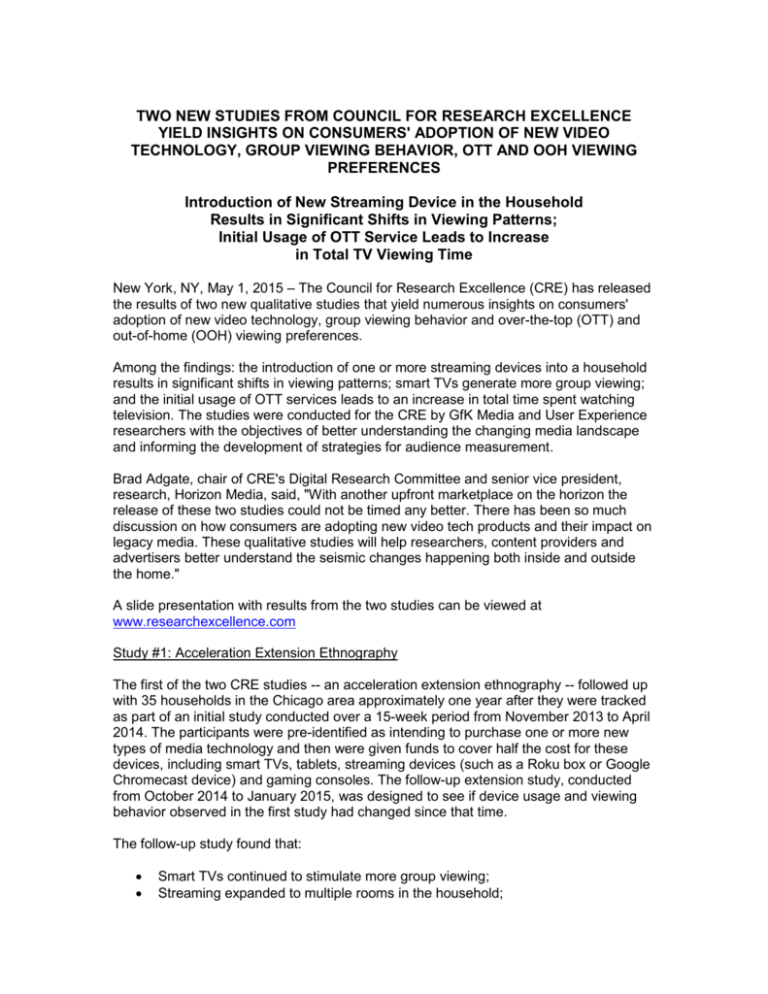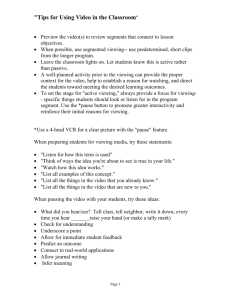May 1st | 2015 Introduction of New Streaming Device in the
advertisement

TWO NEW STUDIES FROM COUNCIL FOR RESEARCH EXCELLENCE YIELD INSIGHTS ON CONSUMERS' ADOPTION OF NEW VIDEO TECHNOLOGY, GROUP VIEWING BEHAVIOR, OTT AND OOH VIEWING PREFERENCES Introduction of New Streaming Device in the Household Results in Significant Shifts in Viewing Patterns; Initial Usage of OTT Service Leads to Increase in Total TV Viewing Time New York, NY, May 1, 2015 – The Council for Research Excellence (CRE) has released the results of two new qualitative studies that yield numerous insights on consumers' adoption of new video technology, group viewing behavior and over-the-top (OTT) and out-of-home (OOH) viewing preferences. Among the findings: the introduction of one or more streaming devices into a household results in significant shifts in viewing patterns; smart TVs generate more group viewing; and the initial usage of OTT services leads to an increase in total time spent watching television. The studies were conducted for the CRE by GfK Media and User Experience researchers with the objectives of better understanding the changing media landscape and informing the development of strategies for audience measurement. Brad Adgate, chair of CRE's Digital Research Committee and senior vice president, research, Horizon Media, said, "With another upfront marketplace on the horizon the release of these two studies could not be timed any better. There has been so much discussion on how consumers are adopting new video tech products and their impact on legacy media. These qualitative studies will help researchers, content providers and advertisers better understand the seismic changes happening both inside and outside the home." A slide presentation with results from the two studies can be viewed at www.researchexcellence.com Study #1: Acceleration Extension Ethnography The first of the two CRE studies -- an acceleration extension ethnography -- followed up with 35 households in the Chicago area approximately one year after they were tracked as part of an initial study conducted over a 15-week period from November 2013 to April 2014. The participants were pre-identified as intending to purchase one or more new types of media technology and then were given funds to cover half the cost for these devices, including smart TVs, tablets, streaming devices (such as a Roku box or Google Chromecast device) and gaming consoles. The follow-up extension study, conducted from October 2014 to January 2015, was designed to see if device usage and viewing behavior observed in the first study had changed since that time. The follow-up study found that: Smart TVs continued to stimulate more group viewing; Streaming expanded to multiple rooms in the household; Those who purchased smart TVs in the first study tended to purchase or plan to purchase additional smart TVs or upgrade gaming consoles; Smart TVs remained the preferred viewing screen in households that also had a streaming device; The majority of households that purchased a new streaming device reported an increase in the amount of streaming consumption, either as additional total viewing time or as a replacement to live TV viewing; Streaming played a role in tablet usage, but tablets were not used as primary screens-- except by kids. Moreover, the study found that viewing patterns are still dynamic and shifting as a result of device/ecosystem churn. Study #2: Longitudinal Ethnography The second study, an ongoing longitudinal ethnography, began tracking a national sample of 100 households in November 2013 and will continue until October 2015. The 100 participant households were selected to represent a balance of urban, suburban and rural characteristics nationwide. The study is examining a number of topics, including OTT viewing, group viewing and out-of-home (OOH) viewing. OTT Viewing The study indicates that unmeasured viewing is on the rise. It found that OTT viewing is most commonly driven by a desire to access specific content, though it may also be driven by a desire, or necessity, to use particular devices or services. Viewers often prefer OTT viewing because it is a way to access a breadth of content on their own schedules, and provides continuity among their connected devices. When individuals start using an OTT service, it frequently increases their total viewing time. Over time, the study suggests, OTT viewing could take the place of other viewing modes. Group Viewing Six different group viewing behavior scenarios were identified based on attention, duration of presence and consistency of presence, from Peripheral Viewing (low level of attention) to Dedicated Group Viewing (high level of attention). The study found: While group viewing affects attention, it does not do so in an exclusively positive or negative way; With multiple screens around to distract viewers, attention fluctuates and bounces between devices unpredictably; Because multiple people are in the room paying various degrees of attention to the main screen, as well as to other devices, it can be difficult to gauge exposure to content. Out-of-Home Viewing The study seeks to determine how viewers' approaches to OOH viewing may vary depending on context and motivation. Three types of OOH viewing were identified: Incidental Viewing: Reliance on whatever device is on hand, generally a smartphone; typically involves short-form video commonly encountered via social media or third party sites. Planned Situational Viewing: Tendency to prepare by selecting a specific device or ensuring access to content; common when travel or long waits are anticipated; frequently involves long-form content. Content Motivated Viewing: Dedication to viewing regardless of location; desire to view time sensitive content; community of viewers is commonly sought for sports or special events. The constraints of Wi-Fi and data plans often influence viewers' service and content choices when they are out of the home, according to the study. Those who do not regularly watch out of the home do report watching when they are traveling or on vacation, the study states. Additional Methodology Notes In-person ethnography was conducted by GfK Media and User Experience researchers to observe viewing behaviors as they occurred, as well as to probe further into specific behaviors. Digital ethnography allowed researchers to gain insight into viewing behaviors over time; all households for both studies were given a personal smart-device serving as a “participant toolkit” including a camera and co-discovery tool with studyspecific apps to enable self-reporting. About the Council for Research Excellence The Council for Research Excellence (CRE) is an independent research group created in 2005 and funded by Nielsen. The CRE is dedicated to advancing the knowledge and practice of audience measurement methodology and comprises senior-level industry researchers representing advertisers, agencies, broadcast networks, cable, syndicators, local stations and industry associations. CRE members represent advertising agencies, media buying firms, media companies, advertisers, digital publishers, social media companies and industry organizations including ABC, AMC Networks, Assembly, CBS, Comcast, Cox Media Group, Discovery Communications, ESPN, Gannett Co., Greater Media, GroupM, Havas Media, Horizon Media, Katz Media Group, Kimberly-Clark, LIN Media, Magna Global, the Media Rating Council, MoffettNathanson LLC, the National Association of Broadcasters, NBC Universal, Nielsen, Omnicom Media Group, Radio Advertising Bureau, Raycom Media, Scripps Networks Interactive, Starcom MediaVest Group, Tribune Co., Turner Broadcasting, 21st Century Fox, Twitter, Universal McCann, Univision, Viacom Entertainment Group and Warner Bros. Television. For more information about the Council for Research Excellence, please visit: http://www.researchexcellence.com/ ### CONTACTS Mark Braff Braff Communications LLC 201-612-0707 mbraff@braffcommunications.com Tom Campo Campo Communications, LLC 212-590-2464 tom@campocomm.com







